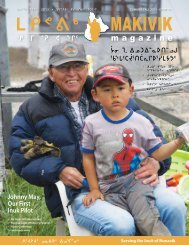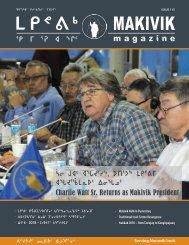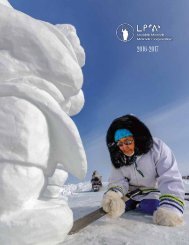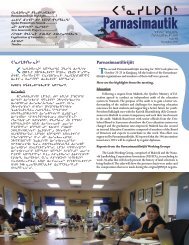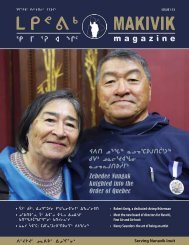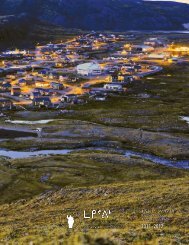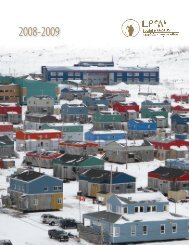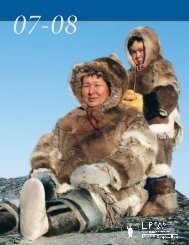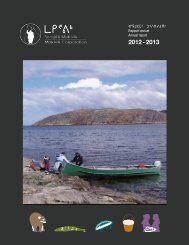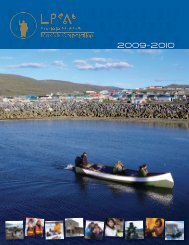2013-2014 Makivik Annual Report
The 2014 Makivik Annual Report
The 2014 Makivik Annual Report
You also want an ePaper? Increase the reach of your titles
YUMPU automatically turns print PDFs into web optimized ePapers that Google loves.
ᑮᓇᓂᕐᓗᑯᓅᓕᖓᔪᓂᒃ ᖃᐅᔨᓴᕐᓃᑦ<br />
Contaminant Research<br />
Recherche sur les contaminants<br />
ᑮᓇᓂᕐᓗᑯᓅᓕᖓᔪᓂᒃ ᖃᐅᔨᓴᕐᓃᑦ<br />
ᐱᓇᓱᖃᑎᒋᑦᓱᒋᒃ ᐃᓕᓐᓂᐊᕕᕐᔪᐊᒃ ᐊᑐᒑᑉ ᐃᓕᓐᓂᐊᕕᕐᔪᐊᖓᓗ ᓚᕚᓪ ᐃᓕᓐᓂᐊᕕᕐᔪᐊᓗ,<br />
ᖃᐅᔨᓴᕐᓂᐅᒐᔭᕐᑐᒥᒃ ᐱᓇᓱᒍᒪᒍᑏᑦ ᐊᑐᐃᓐᓇᕈᕐᑕᐅᓚᐅᔪᕗᑦ ᑏᓯᒻᐱᕆ <strong>2013</strong>-ᖑᑎᓪᓗᒍ<br />
ᑐᓂᔭᐅᑦᓱᑎᒃ ᔭᓄᐊᕆ <strong>2014</strong>-ᒥ ᑕᕐᕋᒥ ᓱᒃᑯᓇᕐᑐᓂᒃ ᐱᓇᓱᒍᑎᖃᕐᕕᒧᑦ ᐃᓕᖓᑦᓱᑎᒃ ᓄᓇᓕᑐᙯᑦ<br />
ᐊᐅᓚᑕᐅᕕᖓᓐᓄᑦ ᑕᕐᕋᐅᓗ ᐱᕙᓪᓕᐊᑎᑕᐅᓂᖏᓐᓄᑦ ᑖᒃᑯᓇᖕᖓᑦ ᑮᓇᐅᔭᖃᕐᑎᑕᐅᔪᒪᑦᓱᑎᒃ.<br />
ᐱᓇᓱᑦᑕᐅᔪᒪᔪᑦ ᐊᑦᓯᕋᐅᑎᖃᕐᑐᑦ ᐃᒫᒃ: ᓂᕿᑐᐃᓐᓀᑦ ᓂᕿᑦᓯᐊᖑᒍᑎᖏᑦ ᓴᐳᑦᔨᓯᒪᒍᓐᓇᐸᑦ<br />
ᒨᑯᔨᐅᑉ ᓱᒃᑯᓇᕐᑐᖏᓐᓂᒃ ᐆᒻᒪᑎᒨᓕᖓᔪᓂᓪᓗ ᖃᓂᒻᒪᓯᐅᓲᓂ? ᐱᓇᓱᒍᑎᓄᑦ ᐃᓚᒋᓕᐅᑦᔨᓃᑦ<br />
ᐊᓪᓚᓯᒪᔪᖕᖑᐃᒍᑕᐅᒪᔪᓂᒃ ᓱᑯᐃᔦᔨᓄᑦ ᐊᐅᓚᑦᔦᒍᑎᖃᕐᓂᓗ ᖃᐅᔨᒪᔭᐅᔪᓂᒃ ᓄᓇᕕᒻᒥᐅᑦ<br />
ᐃᓗᓯᖏᓐᓅᓕᖓᑦᓱᑎᒃ. ᑖᒃᑯᐊ ᐱᓇᓱᑦᑕᐅᔪᑦ, ᑲᔪᓯᐅᒐᕐᑐᑦ ᐱᒋᐊᕐᖃᒥᐅᑦᓱᑎᓪᓗ ᒪᓂᔭᐅᒪᕗᑦ<br />
ᖃᐅᔨᓴᕐᓂᐅᒐᔭᕐᑎᓗᒋᑦ ᖃᓄᖅ ᐊᐊᑦᔨᒌᑦᑎᖏᑦᑐᑦ ᐱᕙᓪᓕᖁᑎᐅᒻᒪᖔᑕ ᓂᕿᑐᐃᓐᓇᓂᑦ<br />
(ᓲᕐᓗ ᓂᕿᑐᐃᓐᓇᓂᓗ ᒪᓐᓂᓂᓗ ᐅᕐᓱᐃᑦ ᖃᓪᓗᓈᕐᑎᑐᑦ ᐃᒫᒃ ᑌᔭᐅᒍᓯᖃᕐᑐᑦ omega-3<br />
polyunsaturated fatty acids, selenium biomolecules, aminoadipic acid, branched<br />
chain amino acids ᐊᒻᒪᓗ acylcarnitine) ᑕᒪᒃᑯᐊ ᓄᓇᕕᒻᒥᐅᓂᒃ ᓴᐳᑦᔨᓯᒪᓲᖑᕙᑦ<br />
ᓱᕐᕋᑕᐅᒍᑎᒋᒍᓐᓇᑕᖏᓐᓄᑦ ᒨᑯᔨᐅᑉ methylmercury-ᖑᓂᕋᕐᑕᐅᔫᑉ, ᑕᒪᒃᑯᐊ ᑌᒣᑦᑐᑦ<br />
ᐱᑕᖃᓪᓚᕆᑦᑐᓯᐊᖑᓲᖑᒻᒪᑕ ᐃᒪᕐᐱᒥᐅᔭᓂ ᓂᕿᓂᑦ ᖃᐅᔨᔭᐅᓯᒪᔪᑦ ᑐᑭᓯᒍᑎᐅᓯᒪᔪᕆᔭᐅᒻᒪᑕ<br />
ᑕᒪᒃᑯᐊ methylmercury ᓂᕿᑐᐃᓐᓇᓃᑦᑐᑦ ᐱᑕᖃᕈᑎᐅᓚᕿᑐᐃᓐᓇᕆᐊᖃᓪᓚᕆᒻᒪᑕ<br />
ᐆᒻᒪᑎᒨᓕᖓᔪᓂᒃ ᐋᓐᓂᐊᓯᒃ ᐃᓚᐅᑎᓪᓗᒋᑦ Type 2-ᒥᒃ ᖃᐅᑦᔨᑕᐅᒍᑎᓖᑦ ᐊᐅᓪᓗᓇᕐᑐᑦ<br />
ᐃᓅᑉ ᐊᐅᖓᓂᒃ ᑲᑭᐊᓗᐊᓕᕐᑎᓯᓯᒪᓲᑦ (T2D) ᑕᒪᑐᒥᖓ ᐱᓇᓱᒍᑎᐅᔪᑦ ᑐᑭᓯᒍᑎᑦᓴᐅᒐᓱᑉᐳᑦ ᑕᒪᓐᓇ ᒨᑯᔨᐅᑦᓱᓂ methylmercury<br />
ᓱᒃᑯᓇᕐᑐᓴᔭ ᓱᕐᖁᐃᑐᒥᒃ ᐊᓱᐃᓛᒃ ᐊᐅᓪᓗᓇᕐᑐᒥᒃ ᐱᒋᐊᕐᑎᓯᓲᖑᒻᒪᒐ ᐱᑕᖃᕐᓂᕋᕐᑕᐅᔪᓪᓗ ᓴᐴᓗᑌᑦ ᓂᕿᑐᐃᓐᓇᓃᑦᑐᑦ ᐊᑑᑎᖃᑦᓯᐊᕋᓗᕐᒪᖔᑕ.<br />
ᑕᒪᑐᒪ methylmercury-ᐅᑉ ᓱᕐᕃᒍᓐᓇᓂᖓ ᐃᓅᑉ ᐅᕐᓱᒥᓂᒃ ᐊᐅᑎᕆᒍᑎᖓᓄᑦ ᖃᐅᔨᓴᕐᑕᐅᒥᔪᖅ ᐊᕐᖁᑕᐅᑎᓪᓗᒋᑦ ᐴᕇᒋᐊᓕᒻᒥ<br />
ᓯᓚᑖᓂᑦᑐᓂᒃ ᐅᑦᑐᕋᐅᑎᑦᓴᓕᐊᕆᒪᔭᐅᔪᓂᒃ ᖃᐅᔨᓴᕈᑎᖃᕐᓂᑯᑦ. ᑖᒃᑯᐊ ᐱᓇᓱᑦᑕᐅᔪᑦ ᐃᑲᔪᕐᓯᓚᕆᓚᖓᔪᑦ ᑲᔪᓯᒍᑎᒋᑦᓱᒋᑦ ᐱᓇᓱᑦᑕᐅᔪᓂᒃ<br />
ᑕᕐᕋᒥ ᑮᓇᓂᕐᓗᑯᓄᑦ ᓱᒃᑯᓇᕐᑐᓂᒃ ᐱᓇᓱᒍᑎᖃᕐᓂᓂᒃ ᖃᐅᔨᓴᕐᓂᖃᕐᒪᑕ ᐴᕇᒋᐊᓕᒻᒥ ᓯᓚᑖᓂᑦᑐᓂᒃ ᐱᕈᕐᑐᑎᒍᑦ ᐱᔭᐅᓚᕿᒃᑲᑕᐅᓲᖑᒻᒪᖔᑕ<br />
©MICHAEL KWAN<br />
Contaminant Research<br />
In collaboration with University of Ottawa and Université Laval, a<br />
research proposal was prepared in December <strong>2013</strong> and was submitted<br />
in early January <strong>2014</strong> to the Northern Contaminants Program<br />
(NCP) of Aboriginal Affairs and Northern Development Canada as a<br />
funding request. The project title is: Do country food nutrients protect<br />
against mercury toxicity and cardiometabolic diseases? Integrating<br />
data from cutting-edge science and mobilizing knowledge towards<br />
Nunavimmuit health. The project, which is ongoing and at its early<br />
stage is proposed to investigate how various beneficial components<br />
rich in country food (e.g., omega-3 polyunsaturated fatty acids,<br />
selenium biomolecules, aminoadipic acid, branched chain amino<br />
acids and acylcarnitine) protect Nunavimmuit from the toxic effect<br />
of methylmercury which is rich in marine mammal-based diet.<br />
Evidence suggested that methylmercury might play an important<br />
role in various cardiometabolic diseases including Type 2 diabetes<br />
(T2D). The project is to determine if validated predictive biomarkers<br />
of T2D are modulated by methylmercury exposure and by putative<br />
protective factors present in the traditional diet. Impact of methylmercury<br />
on fat metabolism is also being investigated through in-vitro<br />
tissue culture experiments. This project strongly compliments the<br />
ongoing NCP project that investigates the in-vitro bioaccessibility<br />
(IVBA) of mercury and selenium in Nunavik country foods (please<br />
see <strong>Makivik</strong> <strong>Annual</strong> <strong>Report</strong> 2012-<strong>2013</strong>, page 90). The integration<br />
of these much-needed data will increase our understanding of<br />
the determinants of T2D and cardiovascular diseases risk in the<br />
Nunavik Inuit population. In addition, it will improve our capacity<br />
to develop and implement interventions that aim to promote the<br />
Recherche sur les contaminants<br />
Un projet de recherche, préparé en collaboration avec<br />
l’Université d’Ottawa et l’Université Laval, a été présenté au début<br />
de janvier <strong>2014</strong> dans le cadre du Programme de lutte contre<br />
les contaminants dans le Nord (PLCN) du ministère des Affaires<br />
autochtones et du Développement du Nord canadien. Ce projet<br />
intitulé « Do country food nutrients protect against mercury toxicity<br />
and cardiometabolic diseases? Integrating data from cutting-edge<br />
science and mobilizing knowledge towards Nunavimmiut health »<br />
démarre à peine. Il a pour but d’étudier de quelle manière certains<br />
composants bénéfiques des aliments traditionnels (p.ex., les acides<br />
gras polyinsaturés oméga-3, les biomolécules de sélénium, l’acide<br />
aminoadipique, les acides aminés à chaîne ramifiée et l’acylcarnitine)<br />
protègent les Nunavimmiut des effets toxiques du méthylmercure<br />
présent dans les mammifères marins. La littérature suggère que<br />
le méthylmercure pourrait jouer un rôle important dans diverses<br />
maladies cardiométaboliques, notamment le diabète de type 2 (DT2).<br />
Le projet souhaite vérifier si des biomarqueurs prédictifs dûment<br />
validés de DT2 sont modulés par l’exposition au méthylmercure<br />
et par des facteurs de protection présents dans l’alimentation<br />
traditionnelle. L’impact du méthylmercure sur le métabolisme des<br />
graisses est également étudié au moyen d’expériences in vitro de<br />
culture de tissus. Ce projet complète bien les objectifs du projet<br />
du PLCN en cours portant sur la bioaccessibilité in vitro (BAIV) du<br />
mercure et du sélénium dans les aliments traditionnels au Nunavik<br />
(Rapport annuel de <strong>Makivik</strong> 2012-<strong>2013</strong>, page 90). L’obtention de<br />
ces données importantes augmentera notre compréhension des<br />
déterminants des risques de DT2 et de maladies cardiovasculaires<br />
ᒪᑭᕝᕕᒃ • <strong>Makivik</strong> Corporation • Société <strong>Makivik</strong> 121






